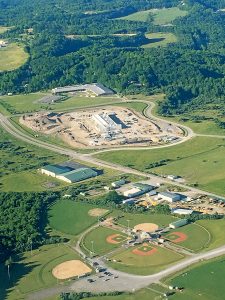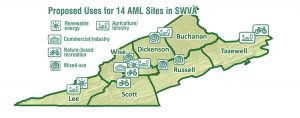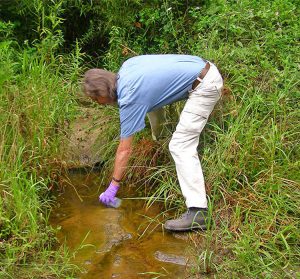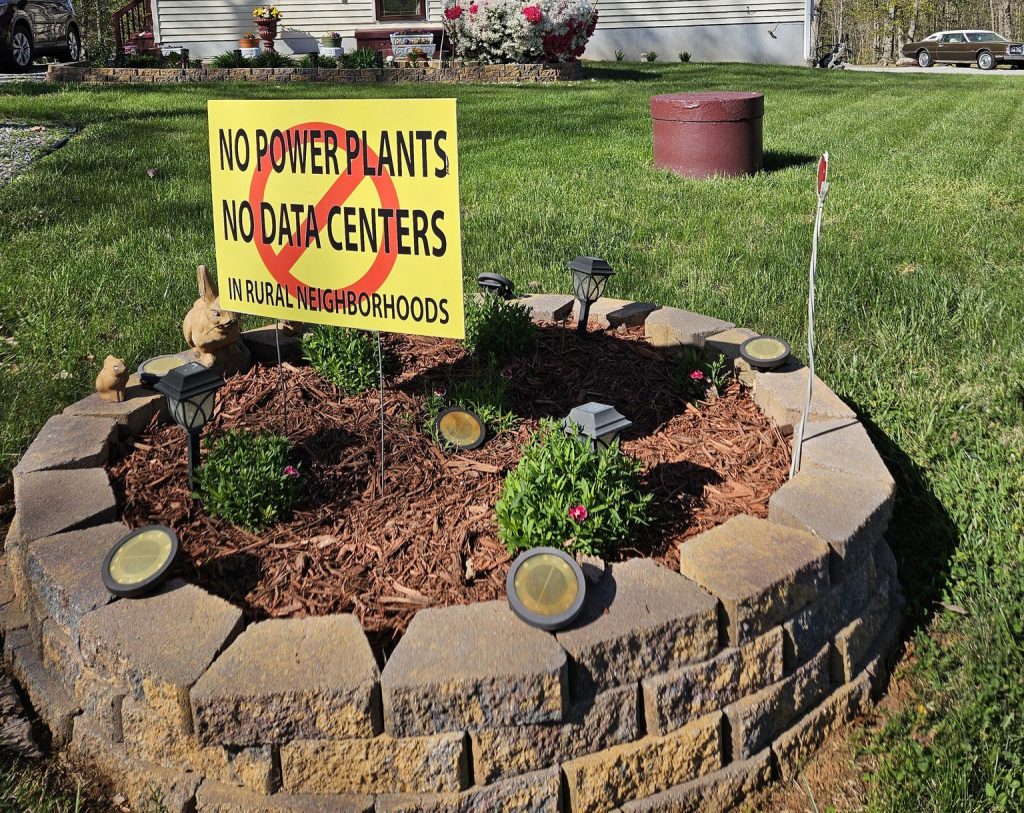Reclaiming Mined Mountains to Beneficial Use
By Elizabeth E. Payne
More than half a century of surface coal mining has left scars across Central Appalachia. As mining operations moved from one coal seam to another, more than a million acres were reduced to barren landscapes or replaced with gravelly grasslands. And mountaintop removal coal mining leveled more than 500 hundred mountains across Appalachia.
At least 233,000 acres of land in Central Appalachia were damaged by mining before 1977 and are in need of reclamation, according to a 2015 analysis by Appalachian Citizens’ Law Center and The Alliance for Appalachia based on federal data. This figure conveys only a fraction of the area impacted by coal production, as it does not include lands mined after 1977. But no inventory of sites mined after this date is currently available.

This data center at left could get its electricity from a solar project proposed for a site near the Wise County Airport in Southwest Virginia. Photo by Gerald Collins.
“There are thousands of [abandoned mine land] features across Appalachia that still need to be addressed,” say Adam Wells, economic diversification program coordinator at Appalachian Voices, the publisher of this newspaper. “These sites are liabilities in many ways, but they are also opportunities for a new approach to economic development in Appalachia.”
Yet determining who is responsible for recovering mined lands to a condition similar to how they were before mining — a process known as reclamation — and for making these lands useful again is a complicated issue.
Paying for Cleanup
On Aug. 3, 1977, the U.S. Congress enacted the Surface Mining Control and Reclamation Act, which established the legislation that continues to regulate coal mining today.
The law created the Office of Surface Mining Reclamation and Enforcement and established its mission. One of the agency’s programs governs the cleanup of abandoned mine lands, a term that refers to mine sites excavated before the passage of SMCRA. To pay for this, the law created the Abandoned Mine Lands Fund, which is financed by a tax on every ton of coal mined.
Another program oversees environmental regulations for coal mines that started after the passage of SMCRA. The law outlines how companies should reclaim the land and gives the agency the authority to ensure companies can pay for the remediation.
The ability to cleanup the sites mined in the 40 years since the passage of the federal law has been threatened by two related issues: bankruptcies and bonding.
Believing that China’s demand for coal would continue to grow, beginning in 2011 many United States coal companies purchased more mines of metallurgical coal — which is used to make steel — than they could afford, including mines in Appalachia.
When Chinese demand and the price for the coal collapsed, so did the companies that bought the mines. Three of the largest American coal companies have filed for bankruptcy in the past year; Alpha Natural Resources filed in August 2015, followed by Arch Coal in January 2016 and Peabody Energy in April.

Students from Appalachian State University plant seedlings on a surface mine in Eastern Kentucky. Photo by Kylie Schmidt
While the executives of these companies were well compensated, the corporations’ obligations for miners’ pensions and for reclamation of mine sites often went unfunded. As of April, Peabody has $1.4 billion in unfunded reclamation needs, Alpha has $640 million and Arch Coal $485 million, according to the Washington Post.
Bankruptcy settlements have addressed only part of these debts. For example, in February 2016, regulators in Wyoming agreed to accept $75 million to forgive a reclamation debt of $485 million, according to the Associated Press. The remaining cleanup costs could fall to taxpayers.
And on Nov. 16, the West Virginia Department of Environmental Protection sued Alpha Natural Resources for fraud, alleging that the company’s executives knowingly hid $100 million in debts in order to secure their bankruptcy settlement.
“There is no doubt that the newly disclosed $100 million shortfall seriously threatens the reorganized debtors’ viability and ability to perform their legal obligations to bond and reclaim their remaining mine site,” the West Virginia Department of Environmental Protection filing stated.
At issue in all of these unfunded obligations is a practice called self-bonding. Before a mining permit is issued, federal law requires mining operators to provide a financial guarantee — or bond — large enough to cover the cost of cleanup after mining is complete. But rather than requiring a company to secure this money from an outside source, many states allow companies to self-bond. This means that they can use their own financial history as a guarantee for their ability to pay for reclamation.
This practice has come under scrutiny after so many coal companies filed for bankruptcy while responsible for billions of dollars in unfunded cleanup costs.
The Office of Surface Mining Reclamation and Enforcement began a rulemaking process in August 2016 to require a more robust analysis and review process before allowing companies to use self-bonding.
Other forms of paying for reclamation after mining also carry risks. Several states, including Kentucky and Virginia, allow companies to use a financial structure called a “pool bond.” In this model, several companies each pay a fraction of their expected cleanup costs into a common pool, out of which reclamation costs can be paid should any of the companies go bankrupt.
This system can support individual bankruptcies, but “the fund is completely unprepared to address the increasingly likely scenario that multiple operators holding multiple permits will decide that they can’t or won’t follow through on their reclamation commitments,” states a blog by Peter Morgan, a staff attorney with the Sierra Club’s Environmental Law Program.
A Case for RECLAIM
However, none of these issues impact mine lands abandoned before the passage of the federal law. For sites mined before 1977, funding sources for reclamation work are well established, if limited.
“In the early years, the [Abandoned Mine Land] program focused on the physical reclamation of hazards affecting coalfield communities,” states the Office of Surface Mining Reclamation and Enforcement website. “More recently, the program began working to reclaim the vitality of communities left impoverished and degraded by past coal mining.”
The RECLAIM Act, a bipartisan bill introduced by Congressman Hal Rogers (R-Ky) that is currently before the U.S. Congress, would create economic opportunities in areas historically impacted by coal mining. The bill would accelerate the release of $1 billion from taxes already paid by coal companies and invest the funds in projects such as restoring abandoned mine lands to beneficial use.

A new study shows the potential of 14 abandoned mine land sites in Southwest Virginia to contribute to the local economy.
Click to enlarge.
The economic development potential of 14 abandoned mine land sites in a seven-county region of Southwest Virginia was highlighted in a November report produced by Appalachian Voices, the regional nonprofit that produces this newspaper, Downstream Strategies, an environmental consulting firm, and Coal Mining Engineering Services, a consulting firm specializing in coal mining and reclamation work.
With funding from the RECLAIM Act, the report concludes, these sites could be repurposed to better serve the area through ecotourism, agriculture, renewable energy and commercial development.
The goals of the study were to demonstrate the need for RECLAIM funding and recommend sustainable projects that could create good jobs on former coal mines.
“One of our hopes for this report is to offer place-based, forward-thinking economic development opportunities that reverse the trends of extraction by investing in historically coal-reliant communities,” says report co-author Adam Wells of Appalachian Voices.
According to Gerald Collins, a co-author of the report and owner of Coal Mining Engineering Services, LLC, there are about 50,000 acres of identified abandoned mine lands in the seven-county area. Other coal mining states in Appalachia have even more acres of impacted lands.
“The problems are just as real [in Southwest Virginia] as they are in Kentucky and West Virginia and Pennsylvania,” Collins says.
Abandoned mine land sites are classified by OSMRE based on their level of risk to human health and safety. Priority 1 sites pose an extreme danger to human health and safety, while Priority 2 sites pose a danger to human health and safety but not an extreme one. Priority 3 sites pose environmental risks, but do not directly threaten human health and safety.

All of the sites in the new study have coal mining features, such as this abandoned underground mine portal at a proposed recreational site in Haysi. Photo by Libby Bringner
The federal law requires that Priority 1 and 2 sites must be cleaned up before funds are used to reclaim Priority 3 sites. Because there is a shortage of funds, many Priority 3 sites remain underutilized. But Collins notes that “with the RECLAIM Act, you’re looking at specifically money for [abandoned mine land] sites that have economic development potential.”
One example highlighted in the study is a proposed solar installation on more than 400 acres of land near the Wise County Airport. Much of this land was re-mined and reclaimed since SMCRA, but several Priority 3 features remain, including a mine opening portal, that would make the parcels eligible for RECLAIM funding.
This project already has backing from several local agencies that are eager to provide renewable energy to the area’s growing information technology industry cluster. According to the November report, the land could support a 20-megawatt solar installation and provide more than 200 local full-time jobs during construction and three permanent positions after construction.
“There’s a lot of potential,” Evan Fedorko of Downstream Strategies says. “[Some] folks just aren’t looking for the potential, but they’re just continuing to be discouraged or despondent about [unreclaimed areas]. And there’s a lot of potential there.”
Fedorko is particularly interested in seeing some of the mine lands reused for agricultural purposes. He says that he has encountered the misperception that all former mine land sites are unsafe for agriculture, but he insists that this is not true and that testing is available to ensure that no hazardous materials are present on a site.
The authors of the report make several recommendations, including that the wording of the RECLAIM Act should be modified so that some abandoned mine lands that were re-mined after 1977 could be eligible to apply for funding.
Such an expansion of eligibility would increase the pool of potential sites that could be repurposed for economic development. It would also provide a chance for reclamation at sites that have fallen through the cracks.
Restoring Forestland
Before they were mined for coal, most Appalachian peaks and slopes were covered in forests. And many scientists, government officials and environmental advocates hope to see reforestation as part of future reclamation plans.
Leading these efforts is the Appalachian Regional Reforestation Initiative, a coalition of citizens, industry and government representatives within the U.S. Office of Surface Mining Reclamation and Enforcement. The initiative was established in 2004 with the goal of reforesting mine lands in the eastern United States.
Dr. Patrick N. Angel is a senior forester and soil scientist at the agency and a liaison to ARRI. But he began his career as a reclamation inspector for the state of Kentucky and became a federal inspector in 1978 after the passage of SMCRA.
“Before the federal law, trees were growing very, very well on mine sites. But we had this problem of landslides,” says Angel. To eliminate the risk of landslides, SMCRA called for mine lands to be stabilized. But these compacted surfaces were ill-suited for growing the native trees that had existed prior to mining.
“Basically, it created a landscape that could not return to a healthy, productive forest without serious human mitigation.”

This 20-year-old research plot demonstrates the success of Forestry Reclamation Approach. Photo by Matt Barton
Angel followed this approach until nearly two decades ago, when one of his forestry professors helped him realize that the choice needn’t be between safety or trees. It was possible to have both.
Angel says that he and about a dozen other foresters, soil scientists, mining engineers and hydrologists decided to try and change how things had been done for more than 25 years. He recalls his thoughts from that time: “We got to get the mining industry to change the way they are doing reclamation. We’ve got to change the culture of what people think good reclamation looks like. It’s not golf courses, okay. It’s something altogether different.”
Angel and his colleagues were introduced to the Forestry Reclamation Approach, which is now advocated by ARRI and its nonprofit partner Green Forests Work. This method provides guidelines for re-establishing healthy forests on formerly mined lands by establishing a thick layer of loose topsoil, minimizing competition from invasive species and carefully planting select varieties of trees.
In 2007, researchers at Virginia Tech and the University of Maryland determined that more than 740,000 acres of previously mined land in the Eastern United States are suitable for reforestation. While the process is expensive — costing $1000-$1500 per acre, according to Angel — Green Forests Work has planted almost two million trees on nearly 3,000 acres since 2009.
“Up to a million acres of these [former mine] lands could be reforested and a lot of the acres are slopes that you can’t develop and build on, you can’t build roads to, there’s a lot of areas that make more sense to put back into a healthy productive forest,” says Angel.
Citizen Site Inspections
In late August 2016, representatives of Statewide Organizing for Community eMpowerment (SOCM), Tennessee Chapter Sierra Club and Tennessee Clean Water Network participated in inspections at four mine sites in Claiborne County. The inspections took place near Straight Creek, Tackett Creek and several unnamed tributaries, where mining operators had requested a bond release.
As a mining company completes the reclamation process, it applies for a return of the money put forward to cover the cost of cleaning up the site. According to federal rules, the release of a bond occurs in phases as the company completes different stages of reclamation.
SMCRA requires mining companies to announce in local papers when they are requesting a bond release. Environmental groups in Tennessee monitor local papers in areas being mined so that citizens can participate in the process, as is allowed by law.

Axel Ringe, conservation chair of the Tennessee Chapter of the Sierra Club, takes a water sample at an inspection of a mine site. Photo courtesy of Tennessee Chapter of Sierra Club and Statewide Organizing for Community eMpowerment
According to Axel Ringe, the conservation chair of the Tennessee Chapter of the Sierra Club who participated in the site inspections, the group confirmed that the regrading had been done properly, took water samples from sediment ponds and checked that the vegetation species and survival rates met the reclamation plan.
“The purpose of doing this is to get the local community people involved in the process, because they’re the ones that are most directly impacted by the mining,” Ringe says.
Carol Judy, a local community member, participated in the inspection because of her desire for clean water. “I’ve always felt like your water data is trackable, and it’s factual,” she says. “And it gives a body a way to look at long-term water quality impacts through several different lenses.”
Following the inspection of the Claiborne mine sites, the groups submitted their concerns to the Office of Surface Mining Reclamation and Enforcement. But as of press time in late November, they had not heard back on the status of the bond release.
Looking Ahead
After more than half a century of surface mining, few in the coal-bearing regions of Appalachia are unaffected by reclamation issues.
A resident of Dickenson County, Va., who asked not to be named because he lacked permission from all landowners to speak about the site, described his frustration after working unsuccessfully for 10 years to get the effects of mining on his property cleaned up.
Remembering how his land was once used for pasture, and dreaming of how it might one day be used for wind or solar energy generation, he says he just wants something to pass on to his grandchildren.
“It’s not too much,” he says, “but at one time it was beneficial. Now it’s a wasteland.”
Related Articles
Latest News

Leave a comment
Your email address will not be published. Required fields are marked *





Using biosolids and a product that is natural like Proganics to get the soil active again in these mine sites is a great idea. When planting trees sometimes using non natives like Bald Cypress (that were native before the ice age) with their extensive root system would stabilize the mountainside, help improve water quality and provide homes for small animals in their root system and canopy.